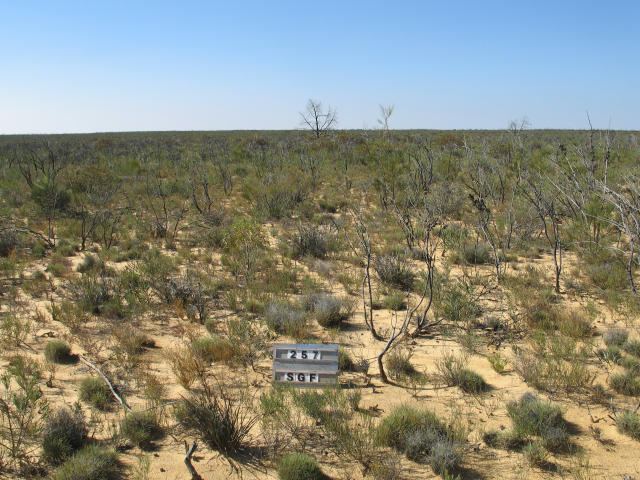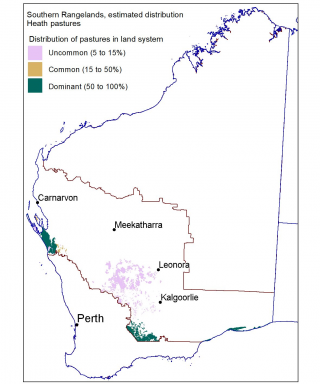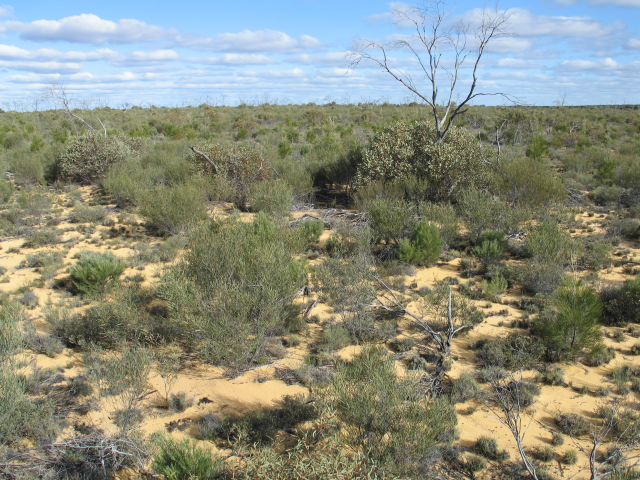Pastoral value – very low to nil
Heath pastures have very low pastoral value and are generally unsuited to pastoral production. They are unattractive to stock although they may provide habitat for organisms that are important to the ecological function of adjacent productive pastures.
Suggested levels of use
Table 1 provides a rough guide to the range of pastoral values for good condition pastures. Even in good condition, these pastures will not usually provide a maintenance ration.
See Introduction to pastures in the southern rangelands of Western Australia for an explanation of how carrying capacities are estimated.
| Condition | Carrying capacity ha/DSE1 | Carrying capacity ha/CU2 | Carrying capacity ha/AE3 |
|---|---|---|---|
| Good | >30 | >210 | ≥252 |
1 DSE is based on the feed energy required to maintain a 45 kilogram liveweight Merino wether with zero weight change, no wool growth additional to that included in maintenance, and walking 7 km/day. 1 DSE has an energy requirement of approximately 8.7 MJ ME/day.
2 CU in the southern rangelands is based on a 400 kg steer at maintenance and equivalent to 7 DSE.
3 AE is based on the feed energy to maintain a 450 kg Bos taurus steer 2.25 years of age, walking 7 km/day. 1 AE has an energy requirement of approximately 73 MJ ME/day and is equivalent to 8.4 DSE.
Management
Heath pastures are prone to burning. Regenerating growth after fire may have some capacity to support some livestock for a very limited time if the regrowth is predominantly annuals or forbs and seasons are favourable. However, these pastures eventually return to being dominated by unpalatable perennial shrubs of limited use for pastoralism.
Survey data show that heath pastures in the southern rangelands are predominantly in good condition.
Soil erosion is not usually associated with a decline in condition in these pastures. Damage is most commonly caused by vehicle traffic and by fire.
Pasture condition
Good
These are moderately close, low or mid-shrublands, sometimes with a well-developed tall shrub stratum. Perennial grasses are not prominent. These pastures are dominated by plants in the Myrtaceae (includes eucalypts and paperbarks) and Proteaceae (includes hakeas, banksias and grevilleas) families. Heath pastures have variable structure and densities, and extremely diverse floristic composition.
Fair and poor
Heath pastures are typically composed of unpalatable species and relatively unaffected by grazing, especially on sandplains. Fair and poor condition is rarely seen, and likely to be associated with fire rather than grazing.
Heath pastures condition photographs

Vegetation structure and composition
Heath pastures are distinctive in being sandplain habitats dominated by mid and low shrubs which form heathland rather than hummock grassland and/or tall acacia shrubland. Heath pastures are more typical of the eastern South-West Botanical Province and South-Western Interzone, compared to the spinifex-dominated sandplains of the Eremaean Botanical Province. The flora recorded during surveys indicate a high level of uniqueness, relative to other habitats.
Heaths generally occur as a moderately close (20–30% projected foliar cover) low or mid shrubland, though occasionally they have a well-developed tall shrub stratum. Perennial grasses are generally not conspicuous. They are characterised by the distinct absence of Eremaean arid zone species and a predominance of plants in the Myrtaceae (myrtle family, which includes melaleucas) and Proteaceae (grevillea and hakea family). Heath pastures have variable structure and extremely diverse floristic composition as a result of many factors, including localised soil characteristics, response to fire and associated successional stages (including competition for resources).
Occurrence
Heath pastures are variable and extend from the coast south of Shark Bay as far inland as south of Southern Cross, and cover an estimated 1.51 million hectares (1.9% of the southern rangelands). Variations in composition and soils occur. Sandplain associations are more extensive compared to coastal heath associations.
Sandplain heath pastures typically occur on very gravelly areas in buff-coloured sands, and are often associated with weathering profiles. Soils may be gravelly sands over mottled gravels.
Coastal heath associations also occur to the south of Shark Bay and along the coastline of the Great Australian Bight south of the Nullarbor. As the coastal heaths are very rarely used for pastoralism, owing to very low to no pastoral value, this pasture description focuses on sandplain heath pastures.

Associated plants
| Common name | Scientific name | Desirability |
|---|---|---|
| Broad leaf wanderrie grass | D | |
| Cotton bush | D | |
| Currant bush | D | |
| Feather speargrass | D | |
| Ragged leaf fanflower | D | |
| Spiked dampiera | D | |
| Unknown | U | |
| Greybeard grass | I | |
| Mulga | I | |
| Myrtles | Thryptomene spp. | I |
| Native pine, white cypress pine | I | |
| Rice flowers | Pimelea spp. | I |
| Rottnest Island pine | I | |
| Sugar brother | I | |
| Wilcox bush | I | |
| Blueberry lily | N | |
| Bottlebrushes, clawflower | Calothamnus spp. | N |
| Grevilleas | Grevillea spp. | N |
| Gums, eucalypts | Eucalyptus spp. | N |
| Hakeas | Hakea spp. | N |
| Native mints | Prostanthera spp. | N |
| Paperbarks | Melaleuca spp. | N |
| Sheoaks | Allocasuarina spp. | N |
| Smokebushes | Conospermum spp. | N |
| Spinifexes | Triodia spp. | N |
| Wattles | Acacia spp. | N |
| Heath myrtles | Baeckea spp. | N |
| Wax flowers | Chamelaucium spp. | N |
| Myrtle | N | |
| Sedges | Lepidobolus spp. | N |
| Sedges | Lepidosperma spp. | N |
| Myrtle | N | |
| Heart-leaf honey myrtle | N | |
| Phebalium | Phebalium spp. | N |
| Snottygobble or geebung | Persoonia spp. | N |
| Pomaderris | Pomaderris spp. | N |
| Verticordias | Verticordia spp. | N |
D = desirable, U = undesirable, I = intermediate, N = no indicator value, ann. = annual
For more information
- Hennig P (2009) ‘An inventory and condition survey of the lower Murchison River area Western Australia’, Technical bulletin 96, Department of Agriculture and Food, Western Australia, Perth.
- Payne AL, Spencer GF and Curry PJ (1987) ‘An inventory and condition survey of rangelands in the Carnarvon Basin Western Australia’, Technical bulletin 73, Western Australian Department of Agriculture, Perth.
- Payne AL, Van Vreeswyk AME, Leighton KA, Pringle HJ and Hennig P (1998) ‘An inventory and condition survey of the Sandstone-Yalgoo-Paynes Find area, Western Australia’, Technical bulletin 90, Department of Agriculture, Western Australia, Perth.
- Waddell PA and Galloway PD (in prep.) ‘Land systems, soils and vegetation of the southern Goldfields and Great Western Woodlands of Western Australia’, Technical bulletin 99, Department of Primary Industries and Regional Development, Western Australia.
- Waddell PA, Gardner AK and Hennig P (2010) ‘An inventory and condition survey of the Western Australian part of the Nullarbor region’, Technical bulletin 97, Department of Agriculture and Food, Western Australia.

